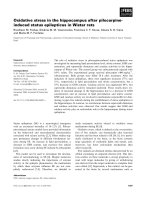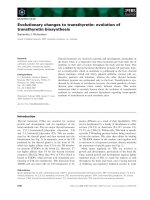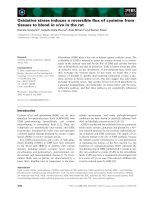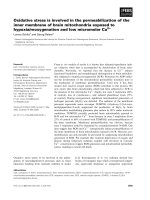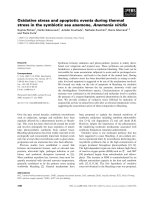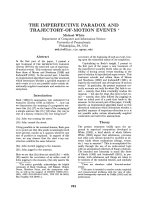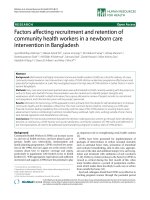Báo cáo sinh học: " Oxidative stress, thermogenesis and evolution of uncoupling proteins" doc
Bạn đang xem bản rút gọn của tài liệu. Xem và tải ngay bản đầy đủ của tài liệu tại đây (639.27 KB, 5 trang )
Minireview
OOxxiiddaattiivvee ssttrreessss,, tthheerrmmooggeenneessiiss aanndd eevvoolluuttiioonn ooff uunnccoouupplliinngg pprrootteeiinnss
Eduardo Rial* and Rafael Zardoya
†
Addresses: *Centro de Investigaciones Biológicas, CSIC, Ramiro de Maezu 9, 28040 Madrid, Spain.
†
Museo Nacional de Ciencias Naturales,
CSIC, Gutiérrez Abascal 2, 28006 Madrid, Spain.
Correspondence: Eduardo Rial. Email:
OOxxiiddaattiivvee ssttrreessss,, eenneerrggyy ddiissssiippaattiioonn,, aanndd tthheerrmmooggeenneessiiss
Organisms living in an oxygen-rich environment have to
overcome the dangers posed by highly reactive oxygen-
derived free radicals, the so-called reactive oxygen species
(ROS). To protect against damage by ROS, all biological
systems have evolved complex antioxidant mechanisms
composed of low molecular weight compounds (such as
glutathione and vitamin E) and enzymes such as catalase,
superoxide dismutase or glutathione peroxidase. As the
mitochondrial respiratory chain is probably the major site
of ROS production, and the rate of ROS formation increases
when respiratory rates are low, cells also evolved means of
accelerating respiration and thus reducing the damage
caused by free radicals. One such mechanism involves an
increase in the permeability of the inner membrane of the
mitochondrion, so that protons pumped by the respiratory
chain can return to the matrix. The uncoupling proteins
(UCPs), a family of transporters belonging to the mitochon-
drial carrier protein superfamily, which is found in all
eukaryotic organisms, provide the pathway for proton re-
entry. Once a mechanism to increase respiration was
operative, it was subsequently accommodated (co-opted in
evolutionary terms) to fulfill other physiological roles such
as maintenance of body temperature or even control of
energy balance.
Brown fat is a thermogenic tissue only present in eutherian
mammals. Heat generation in brown adipose tissue relies
on the above-described modification of the mitochondrial
proton circuit, which allows fast substrate oxidation with-
out ATP synthesis. This low coupling of oxidative phos-
phorylation was recognized in the 1960s, and was soon
related to the thermogenic activity of the tissue. The un-
usually high proton permeability of brown-fat mitochon-
dria was shown to be inhibited by purine nucleotides and
activated by fatty acids. In 1978, Nicholls and co-workers,
using photoaffinity labeling with nucleotides, identified
UCP1 (initially named UCP) as the protein responsible for
the proton permeability [1]. The fatty-acid activation of
UCP1 has great physiological importance: when nor-
adrenaline signals the initiation of thermogenesis, fatty
acids are released, and become both substrates for oxidation
and the second messengers that activate UCP1. Non-
shivering thermogenesis is particularly important in
AAbbssttrraacctt
The uncoupling protein UCP1 provides eutherian mammals with an efficient thermogenic
mechanism. Recent work published in
BMC Evolutionary Biology
, following the identification
of UCP1 orthologs in non-eutherians, concludes that this unique function appeared after
sequence divergence and purifying selection that allowed functional co-option.
Journal of Biology
2009,
88::
58
Published: 16 June 2009 (doi:10.1186/jbiol155)
Journal of Biology
2009,
88::
58
The electronic version of this article is the complete one and can be
found online at />© 2009 BioMed Central Ltd
hibernating and newborn mammals. Interestingly, in the
Suidae (pigs and wild boars), the UCP1 gene is disrupted,
and therefore piglets have poor thermoregulation. This
mutation event occurred some 20 million years ago, and is
correlated with an intriguing behavioral adaptation in that
suids are seemingly the only members of the Artiodactyla
that build nests before giving birth [2].
The morphology and physiological function of brown and
white adipocytes are markedly different. Brown adipocytes
present a multilocular distribution of triglyceride deposits
and contain numerous mitochondria packed with cristae,
consistent with their high metabolic activity. White adipo-
cytes, on the contrary, primarily have an energy storage
function, and thus mitochondria are scarce. Recent work
has shown that brown and white adipocytes have distinct
embryonic origins. Brown adipocytes derive from the same
myogenic progenitors as skeletal muscle cells; the trans-
criptional activator PRDM16 is the key factor determining
whether muscle cells or brown adipocytes are produced [3].
TThhee mmiittoocchhoonnddrriiaall ccaarrrriieerr ssuuppeerrffaammiillyy
The sequencing of the first mitochondrial carriers (adenine
nucleotide translocator (ANT), phosphate carrier (PiC) and
UCP) revealed that these metabolite transporters have
common structural features and thus belong to the same
protein family. The most striking feature is their internally
repetitive structure, in which a unit sequence of 100 amino
acids is repeated three times. Each repeat contains two
transmembrane segments linked by a long hydrophilic loop
(Figure 1). The three loops are oriented toward the matrix
side of the inner membrane, and include the conserved
sequence motif that is currently used to identify potential
members of the superfamily (NCBI conserved domain
Pfam00153, mito_carr superfamily). The elucidation of the
three-dimensional structure of the ANT has confirmed this
structural arrangement [4]. Therefore, it appears that the
protein superfamily evolved by triplication of a primordial
protein that contained two transmembrane domains. More-
over, as mitochondrial carriers do not appear to have ortho-
logs in prokaryotes, it has been proposed that the ancestral
mitochondrial carrier may be an evolutionary innovation of
the ancestral cell that became host to the bacterial endo-
symbiont that eventually became a mitochondrion. Subse-
quent diversification generated the carrier superfamily that
ensures the highly dynamic traffic required for the full
integration of the mitochondrion into cellular metabolism.
For two decades the function of UCP1 from brown adipose
tissue was considered to be a unique mechanism evolved in
eutherian mammals to allow regulated dissipation of the
proton gradient when non-shivering thermogenesis was
required. Furthermore, the presence of a nucleotide-binding
site in UCP1 was considered reminiscent of that found in
the ANT. Since 1997, however, proteins with relatively high
sequence similarity to UCP1 have been found in plants and
other animals, including invertebrates, making up a distinct
UCP protein family within the larger mitochondrial carrier
protein superfamily. The functions of these other members
of the UCP protein family are not fully established, but
available data point to a general role in protection against
oxidative stress. As mentioned earlier, the acceleration of
respiration due to UCP-mediated uncoupling would lead to
a reduction in ROS production by the respiratory chain.
There are now many known examples of UCPs being
upregulated in physiological situations of oxidative stress,
and thus they are widely considered to be part of the
antioxidant defense system of eukaryotes [5].
In a phylogenetic analysis of the mitochondrial carrier
protein superfamily made by our group in 2006 [6] (inset in
Figure 2), each member was recovered as a distinct paralog
(except UCP3). According to our reconstructed phylogeny,
58.2
Journal of Biology
2009, Volume 8, Article 58 Rial and Zardoya />Journal of Biology
2009,
88::
58
FFiigguurree 11
Three-dimensional structure of the adenine nucleotide translocator.
((aa))
Ribbon representation of the structure of the three sequence
repeats that constitute the transporter.
((bb))
Lateral view of the
complete three-dimensional structure of the carrier. Modified from [4]
with permission from Gérard Brandolin.
H1
H1
H2
H2
H3
H3
H4
H4
H5
H5
C-ter
N-ter
C2
C1
H6
H6
h34
h34
Loop M2
h12
h12
Loop M1 Loop M3
Inner
mitochondrial
membrane
Inside
Ouside
h56
h56
(a)
(b)
/>Journal of Biology
2009, Volume 8, Article 58 Rial and Zardoya 58.3
Journal of Biology
2009,
88::
58
FFiigguurree 22
Evolutionary relationships of UCP1-3 family members. We have reconstructed a phylogeny using a total of 161 protein sequences of UCP1-4
retrieved from GenBank, and aligned using Mafft v. 6.626 with the L-INS-i strategy. A final alignment of 281 positions was obtained after removing
ambiguous positions using Gblocks v.0.91b. The JTT+I+G was selected as the best-fit evolutionary model using Prottest v. 2.0. The maximum
likelihood tree (-lnL = 15417.6) was inferred using PhyML v. 2.4.4 with midpoint rooting. An approximately unbiased test performed using RaxMLv.
7.0.4 and Consel v. 0.1 determined that the constrained tree (-lnL = 15433.2) shown in the figure was not significantly different (
P
> 0.05) and, thus,
within the confidence set. Bootstrap analysis was performed using RaxML at the Cipres Portal, and bootstrap values for relevant nodes are shown in
the tree. Taxonomic groups are represented by different colors. Inset: phylogeny of mitochondrial carrier proteins adapted from [6]. Our
reconstructed phylogeny shows animal UCP4 and UCP5 (also termed BMCP1) as a sister group of plant UCPs and animal UCP1-3. The other
members of the superfamily analyzed - PiC, ANT, OGC (oxoglutarate carrier) and DIC (dicarboxylate carrier) - were found to be more distantly
related paralogs.
0.1
UCP2
UCP3
UCP1
Plant UCP
UCP5
UCP4
DIC
OGC
ANT
PiC
Monotremes and Marsupials Teleost fish InvertebratesEutherian mammals Reptiles (including Aves) Amphibians
UCP2
UCP3
UCP1
UCP4
0.4
80
UCP Sea urchin
76
83
97
99
75
86
57
87
69
99
92
50
68
86
99
77
88
50
67
92
78
89
75
92
55
new functions within the superfamily have generally been
achieved through gene duplication and subsequent func-
tional diversification leading to high substrate specificity.
Nomenclature of protein families should be based on
homology, which is determined through phylogenetic
analyses. In this regard, the reconstructed phylogeny of the
mitochondrial carrier protein superfamily may prompt
revision of its current nomenclature. UCP1-3 and plant
UCPs share a common ancestor to the exclusion of animal
UCP4 and 5, which therefore may need to be renamed. The
definition of a mitochondrial transporter as an ‘uncoupling
protein’ implies the recognition that its activity results in a
controlled dissipation of the proton gradient. However, the
consensus on the transport activities of the different UCPs
gets poorer as we move away from UCP1. The scenario is
even more complex because there is evidence that some
mitochondrial carriers may also act as uncoupling
proteins. Thus, the ANT or the PiC can increase the proton
conductance in the presence of high concentrations of
fatty acids. Future research will probably reveal differences
in the molecular mechanism used by the different
members of the UCP family to achieve the increase in
respiration, in the regulation of their activity or even in
their physiological roles.
TThhee eevvoolluuttiioonn ooff tthhee UUCCPP ffaammiillyy
To throw more light on the diversification of the UCP
family and the evolution of the apparently unique function
of UCP1 in thermogenesis, several recent phylogenetic
analyses have focused on vertebrate UCP1-3 relationships
[7-11]. The work of Hughes and Criscuolo published
recently in BMC Evolutionary Biology [7] has confirmed
previous studies indicating that the UCP family evolved
through a series of gene duplications [8]. We have made a
reconstructed phylogeny of vertebrate UCP1-3 using
animal UCP4 as outgroup (Figure 2) that is in good
agreement with those previously published [7,10,11]. As
shown in the figure, UCP4 has been widely reported both
in invertebrates and vertebrates, but apparently no
duplications occurred during the evolution of this paralog.
In contrast, vertebrate UCP1-3 acquired much of their
diversity through two rounds of gene duplication [7,8,10].
The ancestor of vertebrate UCP1-3 first duplicated into
UCP1 and the common ancestor of UCP2-3, which
subsequently duplicated into UCP2 and UCP3. Each of the
three paralogs is found in fish, amphibians, and mammals.
Strikingly, UCP1 and UCP2 have not been reported in
birds, nor UCP1 in sauropsids. These proteins have a single
ortholog in invertebrates (it has been reported in, for
example, a deuterostome (the sea urchin), but not in the
fully sequenced protostome genomes of Drosophila and
Caenorhabditis).
The phylogenetic analyses based on vertebrate UCP protein
sequences, together with the reported conservation of
syntenic regions, demonstrates that there are orthologs of
UCP1 in mammals, amphibians, and fish [7,8,10,11].
Hence, UCP1 is found in vertebrates with and without
non-shivering thermogenesis. The long branch leading to
eutherian UCP1 is indicative of strong structural diver-
gence, and the studies of Hughes and Criscuolo [7] and
Hughes et al. also in BMC Evolutionary Biology [10] indicate
that observed amino acid changes are due to purifying
rather than positive selection. UCP1 from eutherian
mammals presents two distinct biochemical properties: a
high nucleotide-sensitive basal proton conductance in the
absence of fatty acids; and a high affinity for fatty acids
(physiological activators). Hence, it seems clear that
structural divergence was accompanied by a functional
shift. It can be envisaged that ancestral UCP1 probably had
a role in protection against oxidative stress in the tissues
where it was expressed, and that the coexistence of paralogs
(UCP2 and 3) that could fulfill this function, together with
the restriction of UCP1 expression to brown adipose tissue,
allowed it to assume the thermogenic role in eutherians
[10]. The recovered phylogeny should prompt further
characterization of the biochemical activity and regulation
of fish and marsupial UCP1 orthologs, which are likely to
be different from that of eutherian UCP1. Interestingly, the
expression of the carp UCP1 in the liver decreases when
fish are exposed to cold, thus ruling out a thermogenic
function [12].
Although the uniqueness of the properties of UCP1 in
eutherians has provoked lengthy discussions in the litera-
ture, the biochemical characterization of mutants designed
to test the molecular basis of differences between UCP
paralogs is now providing clear answers. Thus, the substi-
tution of Glu134 by Asp in UCP1 results in a marked
decrease in the basal proton conductance [6]. Glu134 is a
shared derived residue of eutherian UCP1, this position
being occupied by Asp in all other UCPs. Even in the carp
UCP1, position 134 is Asp, and the biochemical
characterization of carp UCP1 revealed no nucleotide-
sensitive basal proton conductance [12]. In addition,
several groups have searched for the domain that confers
the high affinity for fatty acids on UCP1 by generating
protein chimeras of domains from UCP1, UCP2 and
UCP3. These studies showed that the hydrophilic loop that
connects transmembrane domains 3 and 4 is responsible
for the high fatty-acid affinity of UCP1. These specific
transport properties fit with the regulation of
thermogenesis, and provide evidence that eutherian UCP1
has evolved to achieve its heat-generating capacity in the
physiological context provided by the brown adipocyte.
58.4
Journal of Biology
2009, Volume 8, Article 58 Rial and Zardoya />Journal of Biology
2009,
88::
58
AAcckknnoowwlleeddggeemmeennttss
We acknowledge the support from the Spanish Ministry of Science and
Innovation to ER (BFU2006-08182 and Consolider-Ingenio 2010
CSD2007-00020) and RZ (CGL2007-60954). Due to journal policy, we
have only sparingly referenced the literature and apologize to those
whose work we were unable to specifically mention.
RReeffeerreenncceess
1. Nicholls DG, Rial E:
AA hhiissttoorryy ooff tthhee ffiirrsstt uunnccoouupplliinngg pprrootteeiinn,,
UUCCPP11
J Bioenerg Biomembr
1999,
3311::
399-406.
2. Berg F, Gustafson U, Andersson L:
TThhee uunnccoouupplliinngg pprrootteeiinn 11 ggeennee
((UUCCPP11)) iiss ddiissrruupptteedd iinn tthhee ppiigg lliinneeaaggee:: aa ggeenneettiicc eexxppllaannaattiioonn ffoorr
ppoooorr tthheerrmmoorreegguullaattiioonn iinn ppiigglleettss
PLoS Genet
2006,
22::
e129.
3. Seale P, Bjork B, Yang W, Kajimura S, Chin S, Kuang S, Scimè
A, Devarakonda S, Conroe HM, Erdjument-Bromage H,
Tempst P, Rudnicki MA, Beier DR, Spiegelman BM:
PPRRDDMM1166
ccoonnttrroollss aa bbrroowwnn ffaatt//sskkeelleettaall mmuussccllee sswwiittcchh
Nature
2008,
445544::
961-967.
4. Pebay-Peyroula E, Dahout-Gonzalez C, Kahn R, Trézéguet V,
Lauquin GJ, Brandolin G:
SSttrruuccttuurree ooff mmiittoocchhoonnddrriiaall AADDPP//AATTPP
ccaarrrriieerr iinn ccoommpplleexx wwiitthh ccaarrbbooxxyyaattrraaccttyylloossiiddee
Nature
2003,
442266::
39-44.
5. Krauss S, Zhang CY, Lowell BB:
TThhee mmiittoocchhoonnddrriiaall uunnccoouupplliinngg
pprrootteeiinn hhoommoolloogguueess
Nat Rev Mol Cell Biol
2005,
66::
248-261.
6. Jiménez-Jiménez J, Zardoya R, Ledesma A, García de Lacoba M,
Zaragoza P, Mar González-Barroso M, Rial E:
EEvvoolluuttiioonnaarriillyy ddiiss
ttiinncctt rreessiidduueess iinn tthhee uunnccoouupplliinngg pprrootteeiinn UUCCPP11 aarree eesssseennttiiaall ffoorr iittss
cchhaarra
acctteerriissttiicc bbaassaall pprroottoonn ccoonndduuccttaannccee
J Mol Biol
2006,
335599::
1010-1022.
7. Hughes J, Criscuolo F:
EEvvoolluuttiioonnaarryy hhiissttoorryy ooff tthhee UUCCPP ggeennee
ffaammiillyy:: ggeennee dduupplliiccaattiioonn aanndd sseelleeccttiioonn
BMC Evol Biol
2008,
88::
306.
8. Saito S, Saito CT, Shingai R:
AAddaappttiivvee eevvoolluuttiioonn ooff tthhee uunnccoouupplliinngg
pprrootteeiinn 11 ggeennee ccoonnttrriibbuutteedd ttoo tthhee aaccqquuiissiittiioonn ooff nnoovveell nno
onnsshhiivveerriinngg
tthheerrmmooggeenneessiiss iinn aanncceessttrraall eeuutthheerriiaann mmaammmmaallss
Gene
2008,
440088::
37-44.
9. Schwartz TS, Murray S, Seebacher F:
NNoovveell rreeppttiilliiaann uunnccoouupplliinngg
pprrootteeiinnss:: mmoolleeccuullaarr eevvoolluuttiioonn aanndd ggeennee eexxpprreessssiioonn dduurriinngg ccoolldd
aaccc
clliimmaattiioonn
Proc R Soc B
2008,
227755::
979-985.
10. Hughes DA, Jastroch M, Stoneking M, Klingenspor M:
MMoolleeccuullaarr
eevvoolluuttiioonn ooff UUCCPP11 aanndd tthhee eevvoolluuttiioonnaarryy hhiissttoorryy ooff mmaammmmaalliiaann
nnoonn sshhiivveerriinngg tthheerrmmooggeenneessiiss
BMC Evol Biol
2009,
99::
4.
11. Jastroch M, Withers KW, Taudien S, Frappell PB, Helwig M,
Fromme T, Hirschberg V, Heldmaier G, McAllan BM, Firth BT,
Burmester T, Platzer M, Klingenspor M:
MMaarrssuuppiiaall uunnccoouupplliinngg
pprrootteeiinn 11 sshheeddss lliigghhtt oonn tthhee eevvoolluuttiioonn ooff mmaammmmaalliiaann nnoonnsshhiivveerriinngg
tthheerrmmoog
geenneessiiss
Physiol Genomics
2008,
3322::
161-169.
12. Jastroch M, Buckingham JA, Helwig M, Klingenspor M, Brand MD:
FFuunnccttiioonnaall cchhaarraacctteerriissaattiioonn ooff UUCCPP11 iinn tthhee ccoommmmoonn ccaarrpp:: uunnccoouu
pplliinngg aaccttiivviittyy iinn lliivveerr mmiittoocch
hoonnddrriiaa aanndd ccoolldd iinndduucceedd eexxpprreessssiioonn iinn
tthhee bbrraaiinn
J Comp Physiol
2007,
117777::
743-752.
/>Journal of Biology
2009, Volume 8, Article 58 Rial and Zardoya 58.5
Journal of Biology
2009,
88::
58

